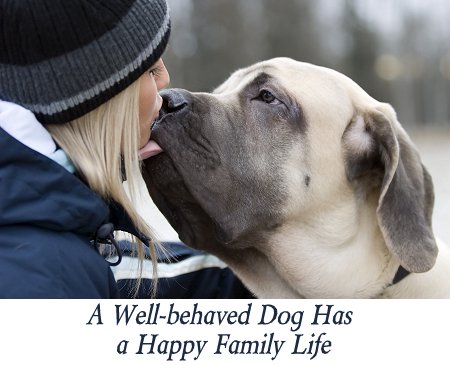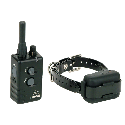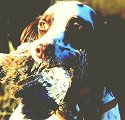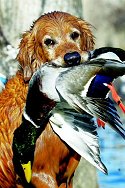Information about Dog Shock Collars
How to Choose the Right Remote Dog Training Collar

The ability to control your dog's behavior (even when you are far away or out of sight) is a critical factor in consistent, reliable training. Remote trainers (often called "dog shock collars") help accomplish this for many different types of dogs in many different circumstances.
Remote pet trainers are designed to help dog owners deter unwanted pet behaviors while in their presence and from a distance. Hunting dog trainers are used to teach and fine tune the pointing, flushing, retrieving, and catching or treeing of game - all accomplished at a distance. There are some differences that are worth noting to help you choose the right collar for you and your individual needs.
 Remote training systems consist of two parts: A hand-held transmitter that broadcasts a radio signal and a receiver worn on the collar of the dog, which translates the signal into a correction of some type that impacts the dog's behavior.
Remote training systems consist of two parts: A hand-held transmitter that broadcasts a radio signal and a receiver worn on the collar of the dog, which translates the signal into a correction of some type that impacts the dog's behavior.
Most use of dog shock collars is for problem solving (such as jumping on people, chasing cars, stealing food, avoiding snakes) or for more involved training (such as obedience training or hunting dog training). Aggressive behavior is NOT a suitable candidate for electronic dog collars under any circumstances without a behavior specialist supervising the activity.
Corrections
Today, not all remote training collars are dog shock collars. Correction methods are varied depending on the system and your individual situation: Some shock collar systems correct your dog using a harmless but unpleasant static shock (most of them). Some use unpleasant audible or inaudible sounds which have previously been used simultaneously with the static (shock) correction until they are understood by the dog to BE the correction. Some adjustable vibration (NEW), warning or pager features. Some use an unpleasant lemon spray deterrent, and some have praise tones.
Timing
Instant (Nick) correction is instantaneous and lasts only ½ sec (or less) no matter how long you hold the button down. Continuous correction lasts as long as you hold the button (emergency shut off in about 10 sec), and Pager or Tone-Only uses only a vibration, buzz or tone to alert or command the dog. (Vibration is a great tool for training deaf dogs).
- Continuous correction timing is most often used in early stages of "negative reinforcement" (often called "escape") training and Nick correction is best used to fine-tune the behavior afterwards. (In our opinion, most training should start with positive reinforcement and demonstration until the dog knows the commands before any negative training consequences are instituted - particularly if you are a novice trainer or if you are training for basic obedience or show obedience). However, "escape" training, (where a dog is able to end a constant-low-level continuous correction by performing some task) is used in many training scenarios and is highly effective. (It should be used only after a thorough understanding of the technique has been mastered.) You must make a decision fairly early in the purchasing equation if you will ever be using the "escape" method, as you must have a collar that is reliable with low-level continuous correction. If you will not be using escape training, you can use a collar with only momentary (Nick) correction.
Correction Levels
The more finesse you have to tailor the correction to the exact temperament of your dog, the more quickly your dog will respond and the less chance there is of over-correction. Every dog will need at least a couple of different levels depending on the circumstances. You will find that a dog who performs flawlessly in the back yard will need a higher level of correction when he is outside his usual environment where distractions are high such as in the park or in the field. He may need a higher level still if he is engaged in a "high adrenaline" state such as when chasing a car, another dog or cat, or honed in on the wrong game. Dogs who are wet will need a lower level of correction due the high conductivity of their wet skin that will channel the full effect directly to them.
The number of different settings for corrections and the way to program them is important and completely individual to each manufacturer and to each collar in their line.
- Some have buttons with each level representing a level of correction. These usually don't offer very much fine-tuning between levels. (Innotek pet trainers).
- Other more moderate to high-end trainers have digital read-outs to show you what level you are using (Sportdog, Innotek & Dogtra Sporting). They make it possible to return to the "best" or "normal" level by choosing the same number on the readout each time. However, LCD readouts are hard to read after dark or if your vision is "not the best".
- Some have rheostat dials that "dial in" the severity and have infinite levels to make fine-tuning exact (Dogtra & Unleashed). The rheostat is right on the top of the transmitter and is easy to work with cold hands or in a hurry. However, they are often difficult to dial a return to the EXACT level that you want to use again and again (Dogtra Sport trainers - 1700, 2000T&B, 2200, 2500T&B & 3500 - are the best of both worlds. You can dial the correction level AND see the LCD number.)
- Some use a thumb-rotated dial coupled with buttons (Sportdog 1200). These are best if they have "stops" at regular intervals to denote precise levels.
- Some have "hot" buttons that jump levels immediately for dangerous or critical situations.
- Most bird hunting is done in the fall and winter when weather can be a factor. Larger buttons (for glove use) or more sturdy equipment is desirable balanced against the size and bulkiness of carrying it.
Tones
Some training collars have warning tones, vibration or pager features. Some have praise tones. Unleashed has a remote trainer that uses ONLY adjustable vibration - NO shock at all - a great new training collar for the sensitive dog or the sensitive owner.
Warning Tones
During more than 30 years of training, we have found that warning tones are rarely useful and often do more harm than good when used in their assumed fashion - as a warning that a more severe correction is coming. They often cause the dog anxiety while making the owner feel that they have "saved" the dog. The trainer who uses the tone to warn often depends on it to the detriment of the dog and the training process - in short, it encourages “nagging" and inconsistent handling. We don't recommend their use in this fashion. Instead, we recommend a collar with a tone-only feature that you can use as a command tone. If you teach the dog to "come" using the tone, you will have a remote recall that will tell him when it is time to return to you. Or you might use it as a "whoa" command to tell him when to stop his forward movement. These are two very positive and useful techniques that make a warning or pager feature valuable.
Praise Tones
A praise tone can be very useful. It is highly regarded as a positive reinforcement tool and it lends itself well to positive reinforcement (or clicker) training. It can be a very valuable tool to let a dog in the field know that he is doing the right thing. A little like the game "hot-cold", a praise tone lets your dog know when he is getting "warmer" and encourages him to continue in the direction you have praised.
Range:
Range is discussed below as far as different types of training. Range is adversely affected by terrain. Mountains, hills, dense trees all inhibit range and will reduce the range claimed by the manufacturers. We also recommend that you reduce the claimed range by about 1/3 in many instances just because "marketing" tends to exaggerate. Range for correction is not usually the reason to have a collar with long reach, as most trainers wouldn't dream of correcting their dog when he is out of sight and might be doing exactly what he is supposed to do. However range for recall is important. That is where the "tone-only" "Come" command (above) is invaluable and range matters.
Transmitter Size:
The size of the transmitter is important when you must work quickly or under adverse conditions. Smallest are the Innotek FS15 and FS25 used for quick, problem solving. Largest are the long range trainers which (necessarily) must have much more antenna. Usually smallest means fewer features. Largest means longer distance. We picture each transmitter so that you can get an idea of what type of equipment you will be carrying.
Receiver Size
Unless you have a very small dog, don't let the receiver size enter into your decisions. All of the companies have finally gotten the size of the receiver down to reasonable dimensions. Further reductions come at a cost. Smaller receivers have less room for electronics, which reduces their range, battery life, and reliability. There are two companies that make tiny dog trainers: Innotek and Petsafe.
Pet Training Systems:

Studies show that 25% of dogs and cats are euthanized or abandoned in their first year because they exhibit unacceptable behavior. Training is one of the most important responsibilities of a pet owner. You will find pet trainers at the lower end of the spectrum for features, distance and dollars. It is not necessary to spend a lot on a pet training system. They are usually used in closer proximity such as urban settings in yards, parks, larger enclosed areas such as school grounds. You would rarely need to use it miles away. Transmitter size is usually smaller and more convenient. Distance is in yards instead of miles. Whether the dog's receiver is waterproof (able to be submerged in water) or just water-resistant (able to get wet but not completely submerged) isn't usually important - water-resistant is usually less expensive - unless you will be training near ponds, lakes or streams. A waterproof transmitter is not necessary unless you think you will actually drop it in water. Although rechargeable batteries are nice, replaceable-battery-trainers are less expensive than collars with rechargeable batteries, and they often keep the price very reasonable for pet trainers.
- Many pet trainers have only a limited number of correction powers (levels)- low for small or timid dogs to high for stubborn or bull-headed dogs. The more levels you have the more precise you can be. Training should be accomplished at the lowest level that gets a response without causing fear or yipping pain.
- If you will be ending only one or two bad behaviors (more problem solving than real training), the collars with fewer levels will work. (See Innotek FS15, FS25, ADV300) However, if you want on-going training, it is best to be able to change more precise levels of correction easily and quickly on-the-fly.
- Some pet trainers come with both a warning (bad tone) and a praise (good dog) button and work well coupled with positive reinforcement (or clicker) training. The praise mode can be used as a remote clicker. (see "Corrections" above for advice about warnings)
Hound Training Systems

You will find that hound training systems are at the high end for both distance and dollars. Hounds run very far afield (needing a mile range or better). Hounds often hunt in packs and many hound trainers come with more than one collar to train or control more than one dog at a time. Often used to break dogs of chasing the wrong type of game, most hound collars have average features and larger transmitters. There may not be a need for hundreds of levels of correction, as the dog chasing the wrong game usually needs a fast, fairly severe correction NOW - not much finesse to it. (This can be a life-saver for the dog headed into dangerous terrain or chasing a dangerous animal and is considered a "hot" situation). However, most collars with such long range incorporate more levels of correction anyway. (Super X Dogtra 3500NCP is designed for X-treme training)
- If you will be away from electrical power for some time, replaceable batteries are nice and instantaneous. However, a good, fully-charged NiMH Battery should hold a charge for several days of hard use. Whether you feel you need waterproof (able to be submerged in water) or just water-resistant (able to get wet but not completely submerged) receivers and transmitters is entirely dependent on the terrain in which you will be hunting or training.
- Long-distance trainers have longer external antennas on the transmitters. (There are no exposed antennas on the dog's collars any more) Some long-distance trainers have beeper-locaters (Dogtra T&B) or you might want to add a beeper to your dog's collar. (Remember that they are sometimes very loud and can rattle a dog that has not worn one before. Be sure to get him used to it much like you would steady him to shot)
Upland Bird Dog Training

Upland bird dog training collars have more range than pet trainers and waterfowl collars but less than hound trainers. However, range for correction is not usually the reason to have a collar with long reach, as most trainers wouldn't dream of correcting their dog when he is out of sight and might be doing exactly what he is supposed to do. However range for recall is important. That is where the tone-only "Come" command is invaluable and range matters.
- Most hunting is done in the fall and winter when weather can be a factor. Larger buttons (for glove use) or more sturdy equipment is desirable - balanced against the size and bulkiness of carrying it. Whether the dog's receiver is waterproof (able to be submerged in water) or just water-resistant (able to get wet but not completely submerged) is entirely dependent on terrain. A necessity if you will be training near ponds, lakes or streams. A waterproof transmitter is usually not necessary unless you think you will actually drop it in water.
- If you will be away from electrical power for some time, replaceable batteries are nice and instantaneous. However, a good, fully-charged NiMH Battery should hold a charge for several days of hard use. Dogtra Super X has new Lithium-Polymer batteries with fast charger.
- Long-distance trainers have longer external antennas on the transmitters. (There are no exposed antennas on the dog's collars any more). Some long-distance trainers have beeper-locaters or you might want to add a beeper to your dog's collar. (Remember that they are sometimes very loud and can rattle a dog that has not worn one before. Be sure to get him used to it much like you would steady him to shot)
Wetlands Bird Dog Training:

These collars have more range than pet trainers but less than hound trainers and upland trainers. However, range for correction is not usually the reason to have a collar with long reach, as most trainers wouldn't dream of correcting their dog when he is out of sight and might be doing exactly what he is supposed to do. However range for recall is important. That is where the "tone-only" "Come" command is invaluable and range matters.
- Most wetlands hunting is done in the fall and winter when weather can be a factor. Larger buttons (for glove use) or more sturdy equipment is desirable - balanced against the size and bulkiness of carrying it. All equipment should be waterproof (able to be submerged in water) since you will be training near and in ponds, lakes, marshes, streams. Cold hands and difficult terrain often lead to dropped transmitters, so a waterproof transmitter is also beneficial.
- If you will be away from electrical power for some time, replaceable batteries are nice and instantaneous. However, These are rarely waterproof and a good, fully-charged NiMH Battery should hold a charge for several days of hard use. Dogtra Super X has new Lithium-Polymer batteries with fast charger.
- Long-distance trainers have longer external antennas. Some long-distance trainers have beeper-locaters or you might want to add a beeper to your dog's collar. (Remember that they are sometimes very loud and can rattle a dog that has not worn one before. Be sure to get him used to it much like you would steady him to shot)